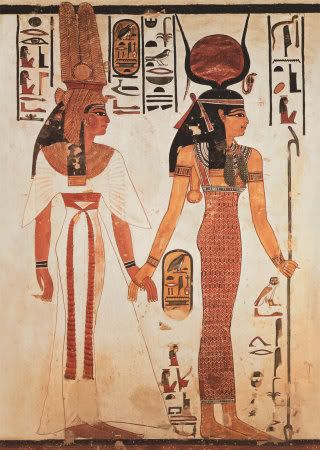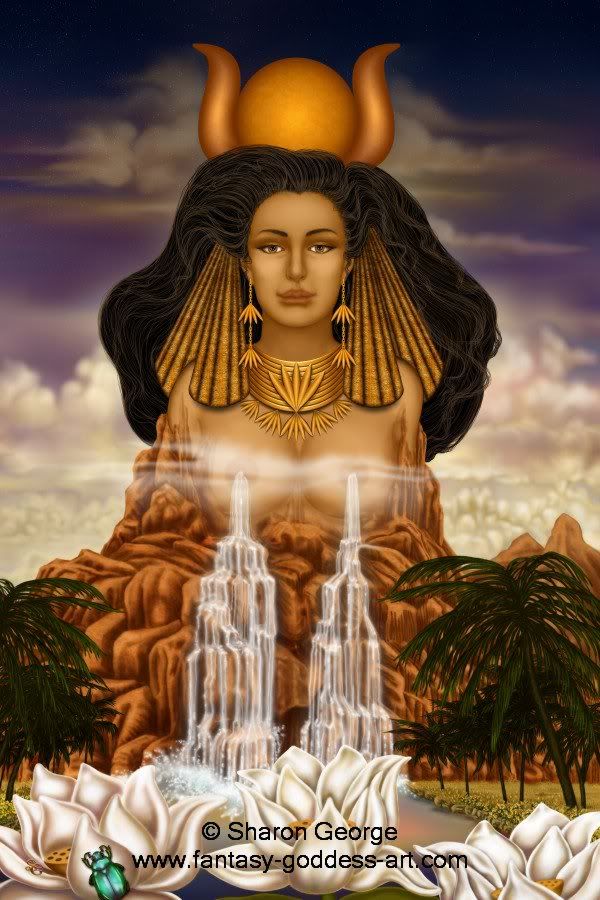Dance was much more than a fun pastime in ancient Egypt. During the Pre-Dynastic Period find female figures of Goddesses and Priestesses dancing with your arms at the top of the head. The act of dancing was undoubtedly a character of great importance in ancient Egypt with regard to religious rituals and celebrations. The women danced generally revered gods of the flood as the god Hapy, in order to ensure a full good and a good harvest.
Ritual dances seen in the frescoes of the tombs show however that men and women never danced together.
The dancers who accompanied the funerals were known as Mu-dancers, they wore crowns and red one type of special clothing. Were hired specifically for these occasions and performed special dances
"It takes more than a lifetime to study Egypt and it takes much more than several lifetimes to understand it."
- You get a smaller waist and rounded forms;
- The wave motion burn the fats and work the muscles of waist and hips;
- The abdomen becomes stronger and more defined;
- It develops body awareness;
- The dance helps weight loss and raises self-esteem.
as it is called that held on to stars and worship a deity, in this case, Osiris, was held in Egypt and is the oldest dance that is known, twenty centuries before the Christian era.
In ancient Egypt, the temple dancers (men and women) formed a special class in society. Their function was to amuse the aristocracy, as kings and their families did not dance. Many were of foreign origin and had basically two types of spectacle: the mime, telling stories through gestures and body postures, and a kind of gymnastics with flexibility and balance.
Much information about the dance you have reached us through the representations in paintings on the walls of burial chambers and the papyri. It is known that besides the religious character, dancing in general, had entertainment features in the palaces of the pharaohs. Sometimes the dances were ordered and based on a theme. Many of these paintings show dancers performing acrobatic moves closer to the contortionist.
When I was born?
When you die?
No man can evoke the days of his birth or provide for its delicious morte.Vem O my beloved!
I forget, drunkenness, incurable ignorância.O our immense world: a grain of sand lost in space.
The whole science of men: words
People, animals and the shadows of the seven climates: Shadows
The result of your meditation: nothing.
Silence, O pain of my soul! Let me look for a remedy.
Do I need to live. The dead have no memory. And I want to review my beloved ....
ed.Radhu When the brightness of day I exasperating when you choose that one eternal night falls upon the world, think in the wake of a child any woman, when she dresses in the garb of belly dancing is allowed in contact with what is most feminine skirt, makeup, ornaments and adereços.Elementos we forgot to adapt ourselves to every day, competitive and stressful, where we giving up on this side. This is therefore the archetype of the dancer ventre.Ela is the very representation of women in all its form and strength. What has been often a ransom for all that lie buried within the mulheres.Seja by the pace of life that cause, or the restraints that are emerging from the time of adolescence. Not to mention also the history of our ancestors, we carry in ourselves. All the fear and insecurities are dissolved by this activity because it teaches something fairly simple, and while difficult to achieve: love yourself. this is the key to face a public (or other) and have to express themselves without fear.
Merit Aton-Belly Dance-Dance of the Heart
Belly dancing, as it is popularly known, is originally called Raks El sharque, which means "dance of the East" or "oriental dance".
One more night of belly dancing in the Nile, in one of several boats that sail the river while diners eat and enjoy the show. The boat moves. The Cairo Tower stands out the window, the building of the Egyptian Radio and Television is slow, the Ministry of Foreign Affairs shows proud rush pharaonic decorating your speakers. The buffet, falafel, tabbouleh, kafta. The Arabic music tells the diners that belly dancing is começar.Assim is Egypt, mysterious and joys contrast
Dance era mucho más que un pasatiempo divertido en el antiguo Egipto. Durante el período predinástico encontrar figuras femeninas de diosas y sacerdotisas bailando con los brazos en la parte superior de la cabeza. El acto de bailar fue, sin duda un personaje de gran importancia en el antiguo Egipto con respecto a los rituales y celebraciones religiosas. Las mujeres bailaban dioses venerados en general, de la inundación como el dios Hapy, a fin de garantizar un buen completo y una buena cosecha.
Los bailarines que acompañaron a los funerales eran conocidos como Mu-bailarines, que llevaban coronas y rojo de un tipo de ropa especial. Bailes especiales fueron contratados específicamente para estas ocasiones y realizó
"Se necesita más de una vida al estudio de Egipto y que se necesita mucho más que varias vidas para entenderlo".
- Usted recibe una cintura más pequeña y de formas redondeadas;
- El movimiento de las olas quemar las grasas y trabajar los músculos de la cintura y las caderas;
- El abdomen se vuelve más fuerte y más definida;
- Se desarrolla la conciencia corporal;
- El baile ayuda a la pérdida de peso y aumenta la autoestima.
como se llama que mantenían a las estrellas y el culto a una deidad, en este caso, Osiris, se celebró en Egipto y es la danza más antigua que se conoce, veinte siglos antes de la era cristiana.
En el antiguo Egipto, las bailarinas del templo (hombres y mujeres) forman una clase especial en la sociedad. Su función consistía en divertir a la aristocracia, como reyes y sus familias no bailaba. Muchos eran de origen extranjero y que, básicamente, dos tipos de espectáculo: el mimo, contando historias a través de gestos y posturas corporales, y una clase de gimnasia con la flexibilidad y el equilibrio.
Mucha información sobre la danza que han llegado hasta nosotros a través de las representaciones en las pinturas en las paredes de las cámaras de sepultura y los papiros. Se sabe que además del carácter religioso, la danza en general, tenían características de entretenimiento en los palacios de los faraones. A veces, las danzas fueron ordenadas y basadas en un tema. Muchas de estas pinturas muestran los bailarines realizan acrobacias más cerca de la contorsionista.
Cuando yo nací?
Cuando usted muera?
Ningún hombre puede evocar el día de su nacimiento o disponer su morte.Vem deliciosa Oh mi amado!
Se me olvide, la embriaguez, incurable ignorância.O nuestro mundo inmenso: un grano de arena perdido en el espacio.
Toda la ciencia de los hombres: las palabras
Las personas, los animales y las sombras de los siete climas: sombras
El resultado de su meditación: nada.
Silencio, dolor de mi alma! Déjame buscar un remedio.
¿Tengo que vivir. Los muertos no tienen memoria. Y yo quiero a revisar mi amada ....
Al tropezar con el peso del dolor, cuando tus ojos no tienen más lágrimas, piensa en los campos verdes brillantes después de la lluvia
ed.Radhu
Cuando el brillo del día exasperante cuando se elige que una noche eterna cae sobre el mundo, pensar en la estela de un niño
cualquier mujer, cuando se viste con el traje de danza del vientre es estar en contacto con lo que es más femenina falda, maquillaje, adornos y adereços.Elementos nos olvidamos para adaptarnos a cada día, competitivo y estresante, donde se renuncia a este lado .
Por tanto, es el arquetipo de la ventre.Ela bailarina es la representación misma de la mujer en todas sus formas y la fuerza. ¿Cuál ha sido a menudo un rescate por todos los que están enterrados en el mulheres.Seja por el ritmo de vida que provocan, o las restricciones que emergen desde el momento de la adolescencia. Por no mencionar también la historia de nuestros antepasados, que llevamos en nosotros mismos.
Todo el miedo y la inseguridad son disueltos por esta actividad porque enseña algo bastante sencillo, y aunque difícil de lograr: el amor a ti mismo. Esta es la clave para hacer frente a un público (o de otro tipo) y han de expresarse sin miedo.
Merit Aton-Belly Dance-Dance of the Heart
Una noche más de la danza del vientre en el Nilo, en una de varias de las embarcaciones que navegan por el río, mientras los comensales comer y disfrutar del espectáculo. El barco se mueve. La Torre de El Cairo destaca la ventana, el edificio de la Radio y la Televisión de Egipto es lenta, el Ministerio de Asuntos Exteriores se muestra orgulloso de la decoración faraónica punta de los altavoces. El buffet, falafel, tabbouleh, Kafta. La música árabe le dice a los comensales que la danza del vientre es começar.Assim es Egipto, misteriosa y alegrías de contraste
Replies to This Discussion
-
Egito The first great culture to infuse the music in their society was ancient Namaste -
-
thank you mody
They are 5 years I went to Egypt and kept good memories of the people and culture
Egypt is beautiful and mysterious
kisses
love,love,peace
Namaste -
© 2024 Created by David Califa. Managed by Eyal Raviv.
Powered by
![]()


